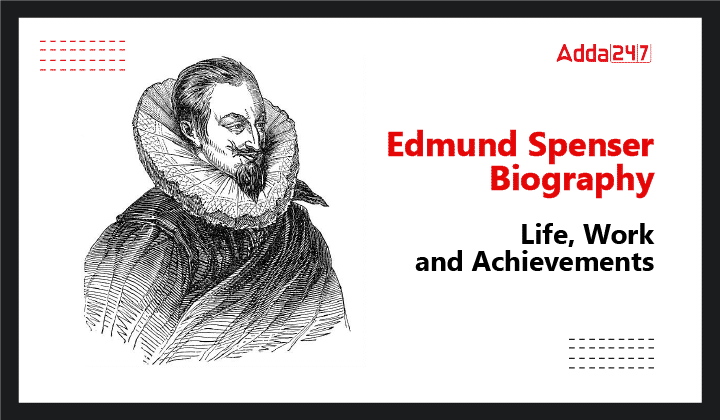Table of Contents
Edmund Spenser is one of the biggest names in English literature. He produced exemplary works of the highest merit and filled the void which was left after Chaucer. His influence, mastery of verse forms, and unique writing style inspired countless poets of later age, including John Milton, Willam Wordsworth, and John Keats. It makes him one of the important initial figures of the Renaissance period. He is one of the must-read authors when it comes to preparing for UGC NET. Thus, let’s take a detailed look into his life, important works along with some important facts you should keep in your mind.
UGC NET English Literature Notes PDF
Life of Edmund Spenser (1552-1599)
Edmund Spenser, one of the most influential figures of the Elizabethan Age was born in either 1552 or 1553 in London. Not much is known about his personal life, although some detail is deduced from some of his sonnets or other works like Prothalamion. He was born into the family of an obscure cloth maker named John Spenser who was married to Elizabeth.
He was educated at the Merchant Taylors’ School and Cambridge. He came to view in London during the year 1579 as a member of the famous literary circle surrounding Sir Philip Sidney.
In 1580, Spenser was appointed secretary to Lord Grey de Wilton, who had just been appointed Lord Deputy of Ireland. He remained in Ireland throughout the rest of his life, only returning to London in between a few times to bring instalments of his famous works for publishing. He married an Irish woman in 1594. He had two children. One of them died in 1598 when his castle at Kilcolman was burned during the Nine Years War. Just after one year, he died “for want of bread”, according to Ben Jonson.
Edmund Spenser’s Life & Timeline
Check out the following table to find out the timeline of Edmund Spenser’s Life. Although very little is known about the personal life of Edmund Spenser, we have mentioned the most important events of Edmund Spenser’s Life.
| Edmund Spenser’s Life and Timeline | |
| Dates | Important Events |
| 1552 | The year Edmund Spenser was born |
| 1569 | Spenser enrols at Pembroke College, Cambridge, where he studies classics and develops his poetic skills |
| 1579 | Came to view in London With the publication of The Shepheards Calendar. |
| 1580 | Spenser moves to Ireland and receives a land grant in County Cork. He serves in various government positions in Ireland throughout his life. |
| 1590 | The first three books of Spenser’s epic poem, “The Faerie Queene,” are published. |
| 1594 | He married Elizabeth Boyle. |
| 1598 | One of his children died. Castle at Kilcolman was burnt. |
| 1599 | On 13 January, Spenser passes away in London. He is buried near the tomb of Geoffrey Chaucer in Westminster Abbey. |
Edmund Spenser’s Popular Works
Edmund Spenser’s writing career was marked by quality over quantity with an abundance of writing in flair and innovations. There are a few must-know works along with a few lesser-known works of Edmund Spenser. Let’s check them out.
The Shepheards Calendar
The first major work of Edmund Spenser that appeared in 1579 was “The Shepheards Calendar”. It consists of twelve eclogues, each representing a different month of the year. An Eclogue is a short pastoral poem that is in the form of dialogue and soliloquy. Spenser adopted the dialect and alliteration of the Midlands and North for this poem. The poem is framed as a series of dialogues between two shepherds, Colin Clout (a poetic persona representing Spenser himself) and Hobbinol (representing Gabriel Harvey, Spenser’s friend and fellow poet).
It emulates Virgil’s Eclogues. This “Shepheards Calendar” was admired by Sir Philip Sidney as a major contribution to the development of English Literature and national culture. Virgil’s works have a huge influence on Spenser as he sort of took him as his personal mentor and guide.
The Faerie Queene
“The Faerie Queene” is Edmund Spenser’s most renowned and influential work, published between 1590 and 1596. It is an epic poem consisting of six books (planned to be twelve but only six were completed), and it stands as one of the longest and most complex poems in the English language.
Each book deals with the adventure of a particular knight who represented some virtue. However, the first three books were published in 1590, and the second set of three was published in 1596. Following his death, two cantons, and two odd stanzas of Book VII appeared. The work was allegorical in nature that combines elements of romance, chivalry, and fantasy and it is dedicated to Queen Elizabeth I praising her rule.
Other minor poems
After this, there are some minor poems showcasing varying degrees of literary capabilities. In 1591, he published “Complaints”, a collection of poems including “The Ruins of Time”, “The Tears of Muses”, “Mother Hubberd’s Tale”, and “The Ruins of Rome”. These are complaints in mournful or mocking tones.
In 1595, he published “Amoretti” and “Epithalamion”. “Amoretti” is an eighty-eight Petrarchan sonnet celebrating the progress of his love. “Epithalamion” was written in honour of his marriage. In 1596, he published “Four Hymns” and “Prothalamion”.
Prose by Edmund Spenser
There is one longish State paper done in the form of a dialogue called “A View of the Present State of Ireland” in 1594. It gives Spenser’s views on the settlement of the Irish question. His opinions are hostile to the Irish.
Edmund Spenser’s Popular Works List
In the following table, the candidates will find the detailed and chronological account of Popular Works by Edmund Spenser. The table consists of the works published by Edmund Spenser and the year the works were published.
| Edmund Spenser Popular Works List | |
| Date of Publication | Title of Works Published |
| 1579 | The Shepherds Calendar |
| 1590 | First three books of The Faerie Queene |
| 1591 | Complaints – a collection of poems and elegies |
| 1594 | A View of the Present State of Ireland |
| 1595 | Amoretti, Epithalamion, Colin Clouts Come Home Againe |
| 1596 | Four Hymns, Prothalamion, Fourth Book of The Faerie Queene |
Conclusion
Edmund Spenser’s enduring legacy in English literature is undeniable. He not only filled the literary void left after Chaucer but also set the stage for the flourishing of poetic innovation during the Renaissance period. His mastery of verse forms, unique writing style, and profound influence on subsequent poets such as John Milton, William Wordsworth, and John Keats make him an indispensable figure in the canon of English literature.
While much remains shrouded in mystery about his personal life, his literary contributions continue to captivate readers and scholars alike. From “The Shepheards Calendar” to the epic masterpiece “The Faerie Queene,” Spenser’s works showcase his poetic genius and enduring relevance. Exploring the life and works of Edmund Spenser provides not only a glimpse into the past but also a profound appreciation for the richness of English literary heritage.
Download UGC NET English Study Notes PDF
The direct Link to download UGC NET English Study Notes PDF has been given below. Check the direct link to download Edmund Spenser Biography Study Notes PDF has been given below.
Download Edmund Spenser Biography Life, Work & Achievements Study Notes PDF




 UGC NET Commerce Syllabus 2025 PDF Downl...
UGC NET Commerce Syllabus 2025 PDF Downl...
 UGC NET Teaching Aptitude Questions Answ...
UGC NET Teaching Aptitude Questions Answ...
 UGC NET Philosophy Syllabus 2025 PDF Dow...
UGC NET Philosophy Syllabus 2025 PDF Dow...




